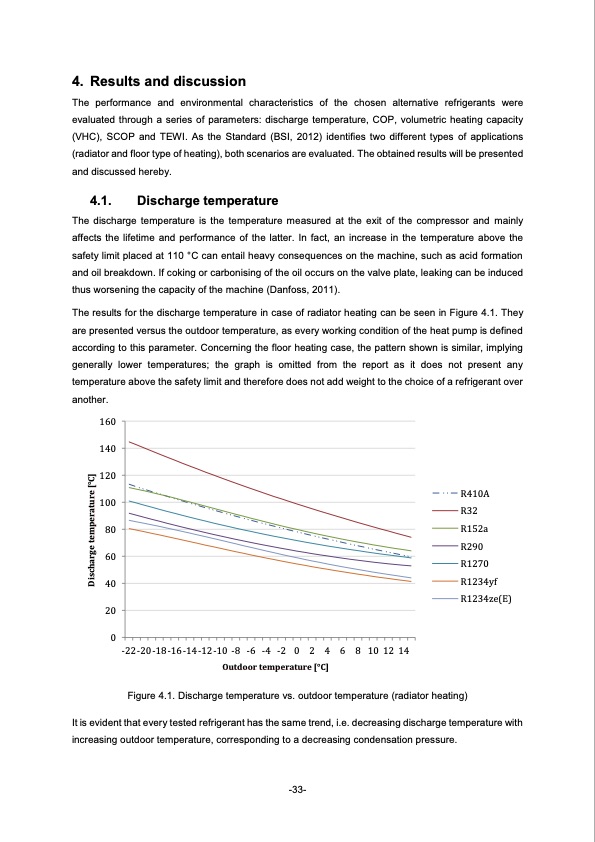
PDF Publication Title:
Text from PDF Page: 042
4. Results and discussion The performance and environmental characteristics of the chosen alternative refrigerants were evaluated through a series of parameters: discharge temperature, COP, volumetric heating capacity (VHC), SCOP and TEWI. As the Standard (BSI, 2012) identifies two different types of applications (radiator and floor type of heating), both scenarios are evaluated. The obtained results will be presented and discussed hereby. 4.1. Discharge temperature The discharge temperature is the temperature measured at the exit of the compressor and mainly affects the lifetime and performance of the latter. In fact, an increase in the temperature above the safety limit placed at 110 °C can entail heavy consequences on the machine, such as acid formation and oil breakdown. If coking or carbonising of the oil occurs on the valve plate, leaking can be induced thus worsening the capacity of the machine (Danfoss, 2011). The results for the discharge temperature in case of radiator heating can be seen in Figure 4.1. They are presented versus the outdoor temperature, as every working condition of the heat pump is defined according to this parameter. Concerning the floor heating case, the pattern shown is similar, implying generally lower temperatures; the graph is omitted from the report as it does not present any temperature above the safety limit and therefore does not add weight to the choice of a refrigerant over another. 160 140 120 100 80 60 40 20 0 -22-20-18-16-14-12-10 -8 -6 -4 -2 0 2 4 6 8 10 12 14 Outdoor temperature [°C] R410A R32 R152a R290 R1270 R1234yf R1234ze(E) Figure 4.1. Discharge temperature vs. outdoor temperature (radiator heating) It is evident that every tested refrigerant has the same trend, i.e. decreasing discharge temperature with increasing outdoor temperature, corresponding to a decreasing condensation pressure. -33- Discharge temperature [°C]PDF Image | Next generation of refrigerants for residential heat pump systems

PDF Search Title:
Next generation of refrigerants for residential heat pump systemsOriginal File Name Searched:
MartinaLonghini_ThesisReport.pdfDIY PDF Search: Google It | Yahoo | Bing
CO2 Organic Rankine Cycle Experimenter Platform The supercritical CO2 phase change system is both a heat pump and organic rankine cycle which can be used for those purposes and as a supercritical extractor for advanced subcritical and supercritical extraction technology. Uses include producing nanoparticles, precious metal CO2 extraction, lithium battery recycling, and other applications... More Info
Heat Pumps CO2 ORC Heat Pump System Platform More Info
| CONTACT TEL: 608-238-6001 Email: greg@infinityturbine.com | RSS | AMP |